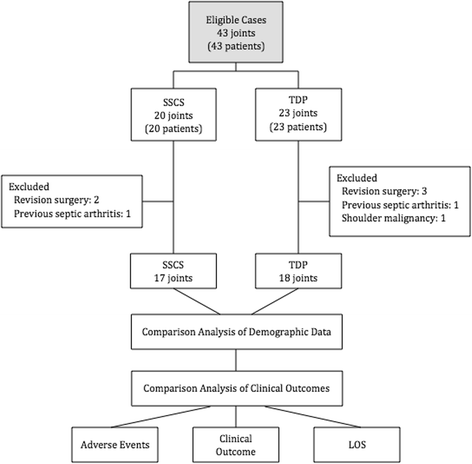Subscapularis- and deltoid-sparing vs traditional deltopectoral approach in reverse shoulder arthroplasty: a prospective case-control study
- PMID: 28705164
- PMCID: PMC5513373
- DOI: 10.1186/s13018-017-0617-9
Subscapularis- and deltoid-sparing vs traditional deltopectoral approach in reverse shoulder arthroplasty: a prospective case-control study
Abstract
Background: With the growth of reverse shoulder arthroplasty (RSA), it is becoming increasingly necessary to establish the most cost-effective methods for the procedure. The surgical approach is one factor that may influence the cost and outcome of RSA. The purpose of this study was to compare the clinical results of a subscapularis- and deltoid-sparing (SSCS) approach to a traditional deltopectoral (TDP) approach for RSA. The hypothesis was that the SSCS approach would be associated with decreased length of stay (LOS), equal complication rate, and better short-term outcomes compared to the TDP approach.
Methods: A prospective evaluation was performed on patients undergoing RSA over a 2-year period. A deltopectoral incision was used followed by either an SSCS approach or a traditional tenotomy of the subscapularis (TDP). LOS, adverse events, physical therapy utilization, and patient satisfaction were collected in the 12 months following RSA.
Results: LOS was shorter with the SSCS approach compared to the TDP approach (from 8.2 ± 6.4 days to 15.2 ± 11.9 days; P = 0.04). At 3 months postoperative, the single assessment numeric evaluation score (80 ± 11% vs 70 ± 6%; P = 0.04) and active elevation (130 ± 22° vs 109 ± 24°; P = 0.01) were higher in the SSCS group. The SSCS approach resulted in a net cost savings of $5900 per patient. Postoperative physical therapy, pain levels, and patient satisfaction were comparable in both groups. No immediate intraoperative complications were noted.
Conclusion: Using a SSCS approach is an option for patients requiring RSA. Overall LOS is minimized compared to a TDP approach with subscapularis tenotomy. The SSCS approach may provide substantial healthcare cost savings, without increasing complication rate or decreasing patient satisfaction.
Keywords: Approach; Cost-effectiveness; Deltopectoral approach; Length of stay; Results; Reverse shoulder arthroplasty; Shoulder; Subscapularis sparing.
Conflict of interest statement
Ethics approval and consent to participate
Ethical committee approval was received from Association des Médecins du Canton de Genève et Société Médicale; protocol 12–26; November 12, 2012. All patients gave informed written consent.
Consent for publication
Not applicable.
Competing interests
PJD received royalties and is a paid consultant for Arthrex. PC is a paid consultant from Wright and Smith and Nephew and received royalties from Wright, Storz, and Advanced Medical Application. The other authors certify that they or any members of their immediate families have no non-financial or financial disclosures (e.g., consultancies, stock ownership, equity interest, patent/licensing arrangements) that might pose a conflict of interest in connection with the submitted article.
Publisher’s Note
Springer Nature remains neutral with regard to jurisdictional claims in published maps and institutional affiliations.
References
-
- Walch G, Wall B. Indication and techniques of revision arthroplasty with a reverse prosthesis. In: Walch G, Boileau P, Mole D, Favard L, Lévigne C, Sirveaux F, editors. Reverse shoulder arthroplasty. Montpellier: Sauramps Medical; 2006. pp. 243–6.
-
- Boileau P, Walch G. The surgical anatomy and osteotomy technique for the humeral head. In: Walch GBP, editor. Shoulder arthroplasty. Berlin: Springer-Verlag; 1999. p. 107–55.
Publication types
MeSH terms
LinkOut - more resources
Full Text Sources
Other Literature Sources


